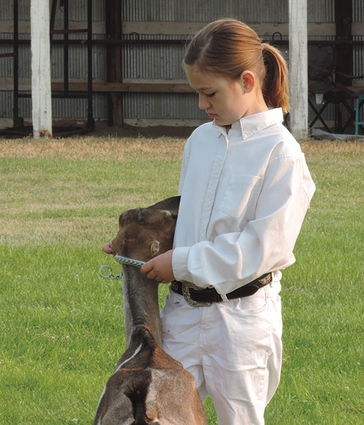Goat with 'no ears' shown at goat show
August 4, 2017

Tracie Mitchell
Victoria Shaffer adjusts the lead on her LaMancha dairy goat Big Momma during the Washakie County Fair goat show Wednesday morning at the Washakie County Fairgrounds in Worland. LaMancha goats have pixie or elf ears.
WORLAND – During the Washakie County Fair goat show Wednesday morning 10-year-old Victoria Shaffer showed her LaMancha dairy goat, Big Mamma, winning grand champion in the junior dairy goat showmanship class and for the LaMancha breed with Big Mamma. What is unusual about Big Mamma is that she appears to have no ears.
Victoria and her mother Beth explained that the origin of the earless goat is unknown, but that the LaMancha was first bred in Oregon. Big Mamma is a cross between an Alpine and Nubian goat, which is where the breed comes from. "She does have ears, they are just short ears called pixie ears," they said. "A lot of people ask us, 'Did you cut the ears off of that goat?' No, this is just how they are born, we do not cut their ears off," they added.
They went on to explain that LaMancha goats can have two types of ears, pixie or elf ears. Elf ears are a little longer, no more than two inches long. The family has Big Momma's daughter who has elf ears because Big Mamma was bred to an Alpine goat and they had just recently sold a buck with elf ears. "We had a little buckaroo that we just sold and his ears were just a little bit longer because his mother was bred to a Nubian. They either have the pixie or elf ears; otherwise they are not considered a LaMancha," they said.
According to the American Goat Society, "The LaMancha was developed in the USA. It has roots in Spain, but its full genetic history is somewhat obscure. LaMancha vary greatly in size, and often tend to be somewhat shorter and blockier than most other breeds of dairy goats. Taller, more refined animals are seen and are acceptable as well. They are widely respected for their docile, even temperament and steady production of milk of fairly high fat content. The hair is short, fine and glossy. The LaMancha face is straight or slightly dished, with the ears being the distinctive breed
characteristic."
The family has other types of dairy and meat goats as well. Vitoria's sister Olivia Shaffer, age 13, won reserve champion best of show dairy goat with her Nubian goat and Victoria won breed grand champion with her Alpine dairy goat. The meat goats that they own are Boer and Spanish goats.
Olivia has been showing goats for three years and Victoria two, so Victoria stated that she might pick on her big sister for winning more ribbons in goats this year. Victoria stated that they are competitive, especially in best udder and compete at home about whose goat is better.
But even with a little sister rivalry, the family works together to take care of not only the goats that they own, but the sheep, chickens, turkeys and rabbits as well. "We stay busy and work together," Beth Shaffer said. "We all work with the animals and we all clean-up after them, but dad hauls the hay," she added.
Victoria is showing sheep, an alpaca borrowed from the neighbor (in today's show at 9 a.m.), her goats, chickens and rabbits this year. "I like showing the sheep the best because they don't fight as much as the goats and they aren't as mean," she said.
Beth is thrilled to be able to give her daughters the opportunity to be in 4-H and work with the animals, especially since she didn't have the opportunity when she was growing up. "We didn't even come to the fair usually and when we did it was just to go look inside. My mom didn't like all this stuff," she said.
Big Mamma can still be seen in the goat and sheep barn through Saturday at the Washakie county Fairgrounds.




